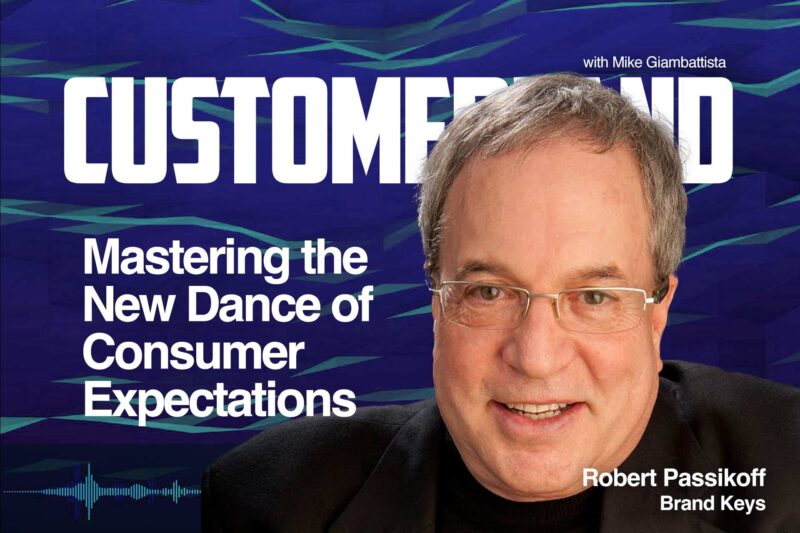Ever wondered why the pull of your favorite brand is so strong, or why some products seem to fade into oblivion while others redefine an entire industry? Join us as we unravel the mysteries of consumer loyalty and the collapse of the traditional marketing funnel. We’re peeling back the layers to reveal how loyalty has evolved from a simple choice between two brands to a complex dance where consumer expectations lead and brands must follow.
In this episode, we’re not just talking about trends; we’re dissecting the intimate relationship between emotional connections and market share. It’s not about Apple versus Samsung or just smartphones and retail – this is about how industry titans capture our hearts and wallets, and why some fail to keep up.
Join Robert Passikoff and me as we examine the seismic shifts in brand allegiance over the last 27 years, highlighting the ‘loyalty juggernauts’ that have mastered the art of aligning with consumer desires. We’ll also look into the crystal ball to see where simplicity and intuitive design are taking industries like streaming and electronics. So tune in, and arm yourself with the knowledge to bridge the gap between what customers expect and what your brand delivers.
This episode of Customerland is sponsored by

Read the full transcript below
Robert Passikoff
What research in the past decade has shown is that very few of the people that entered that traditional “A.I.D.A” (Attention, Interest, Desire, Action) funnel via awareness really ever get to the part of the action. They don’t do anything. There are a lot of people out there who have rejiggered the I put air quotes funnel so that it’s not really a funnel. It’s a different kind of a model. It just it doesn’t have the kind of, you know, straight line, go here, go there when you, when you also combine that with the fact that the, the loyalty paradigm has shifted dramatically as well, I mean what you mean by that we’ve touched on it before, but you know, let’s bring some clarity to that, okay so I’m willing to bet that that I would say 90%.
You know the majority people and you know 90% of the people in our business. When you speak about loyalty, what they are looking at is I buy this, I won’t buy anything else. Thank you very much. It is, you know it is. It is reminiscent of you know, you know the coconut Pepsi. You know I will drink one, I won’t drink the other. And there was, you know, there was a time when that was real, but not really.
Since the 1970s, have you seen, that kind of loyalty model doesn’t exist anymore. And now the difficulty, of course, is that if you go well, I’m loyal to something, it does in fact mean that my initial behavior is going to be directed to the brand to which I’m telling you I’m loyal, I. I have to actually avoid, and even knowing what I know, I have to avoid saying you know, I’m aware of these things, these brands, and you know I’m making a choice. I am in fact making a choice, but I’m making the choice on the basis of the ability for a brand to meet my expectations, and we’ve talked about expectations. We’ve talked about expectations before.
There are reasonable measures and unreasonable demands that consumers make in terms of what they, in terms of what they expect and what they look at in terms of how a brand measures up to what they expect, is the way in which they’re going to make their decision to be loyal. I mean, you know it’s the way, it’s the way the marketplace works, because you know I would remind you that there was a time when, when the Walkman, the Sony Walkman, was something that everyone owned because, oh my god, you could transport music and books and take it with you and, you know, go, walk about, and that was the most successful thing in the world. You know, until you know something about three inches, you know, three inches all and an inch wide. You know, the iPod came along and now you know, someplace in the back of some drawer, a desk, someplace, everyone’s got an eye an iPod not doing it because their expectation had shifted the minute that you put it into a phone.
Now you have everything in the phone and so the, the technological changes also shift your expectations, and now people look and they go okay, here’s, here’s what I want, and there are the, there are the juggernauts, what we call the loyalty juggernauts, who have just the word that I use was transmute. I mean I don’t know what else it is. They have their market share. They have their awareness, because I’m willing to grant awareness to anyone out there. That’s a reasonable competitor, but somehow they’re better meeting expectations than someone else and I don’t measure this. I can’t measure this in the evaluation that we do, the customer loyalty engagement in X every year. But I’m also willing to believe that it’s the nanosecond first brand that people think
And you see it within the categories and of course, there are nuances to this. I mean, there are the brands that touch. They’re the brands that are one and two when it comes to loyalty in a category, although that they’re just and these things and these things shift. But there are also consistencies. There are also consistencies that you regularities that you see in terms of things. I mean, who owns the smartphone category? Well, it kind of depends. I mean, without doing your research on I should have asked the question who owns the search category? Without doing your work on Google and looking it up, you’re either going to say Samsung or you’re going to say Apple, and I mean, without quibbling about precise market shares. That’s how that’s going to work.
So you’re able to transmute what is reasonable market share, a given in terms of awareness, and then the loyalty factor into what now gives you absolute market dominance. And yeah, everyone’s doing. The retailers all have online stuff. But my advice is don’t bet against Amazon. I mean, they just they’re the loyalty juggernaut in terms of that category and that’s what you see.
And again, the expectation issue. I went back to look at some stuff. I sent you some preliminary information the ability to meet expectations that people hold for their categories, for what they ideally want. Even if it’s totally undeliverable, it is emotionally what people want. And if you look at not just the brands that do well because they’re, you look at a category, there are a lot of. There are two or three or four brands in a category that when you read the financials, they’re all doing well. But when you look at it from a loyalty perspective and you look at it from the perspective of how well are they meeting expectations, that range gets really I mean really tight.
So if you think of the ideal at 100%, since a lot of the drivers for loyalty are emotional, it’s often hard to articulate or people don’t want to articulate it, but with the right measures you can get those. I mean psychological measures help do that. The range, the lowest market dominant loyalty juggernaut, is meeting expectations by 80%.
Mike Giambattista
That’s the bottom of the loyalty juggernaut barrel right there the very bottom.
Robert Passikoff
And then you know the category is different, because that’s the nature of categories. But, you know, you look at the average, the average of all the other brands that compete within their categories, and the average is about 65, 66 percent. And so there’s a 15 point difference between 65 and 80. And 80 is the bottom of the I don’t know the. You know the oxymoron – the worst, best brand is at 80 percent, you know, and the top goes up, you know, goes up as high as you know, and I think 95, 96 percent. If you look at someone like Apple, I think Apple is at 95 percent.
And these old correlate with the thing is, is that their ability to meet the expectations correlates with profitability, with share of market? I mean very, very highly. And those are separate financial. You know financial market measures and they count, of course, but this allows you to see where a brand is going to end up. I mean, these are, these metrics correlate extraordinarily highly with how people will behave toward a brand and when you speak, they’re, you know, 15, 18 months out in terms of predicting where these brands are going to end up.
TRIFFT is Smart Loyalty

As of today there are 1237 technologies on G2 listed as Loyalty platforms. There are 560 loyalty technologies on Capterra. My question is – how do you navigate all that?
The answer – if you’re an enterprise-level user – is that there are a handful of organizations out there that are happy to help you figure that out. But if you’re a mid-market user … well, good luck.
There’s a massive pool of options, features, integrations, stack-dependencies and complications – an almost innumerable amount of stuff to sort through just to arrive at some sort of short list.
That was the thinking behind Trifft. Trifft – T R I F F T is a smart loyalty platform designed from the ground up to provide mid-market retail and restaurant operators with a full-featured yet easy to use loyalty solution.
It was built by a team of loyalty veterans who saw that while platform sales were going up, usage and adoption were stagnant because the technologies were:
- Too complicated
- Had too many features
- Needed too much manpower
- Required too much IT input, etc., etc., etc.
Trifft’s entire reason for being is to help mid-market businesses deliver on their complex loyalty strategies without the tech bloat that so often accompanies such things.
That’s Trifft. Smart Loyalty. Trifft. T R I F F T. I O
Mike Giambattista
I hate to make this a sporting event, but I love making it a sporting event. What happens with this research that you’ve been doing now for 27 years is it’s inevitable that people like me would want to compare this year to last year. What were the biggest movers? Who are the winners and losers In terms of loyalty juggernauts? Who are they? And maybe if and I don’t know if your research shows this necessarily, but why are they? So there’s a lot to talk about there, but would you mind if we kind of just went through some of the bigger categories and talked about who the winners are and, if you have it at your fingertips, at what level they’re meeting customer expectations?
Robert Passikoff
Sure.
Mike Giambattista
Sure, that would be huge. I think putting some context to this is really eye-opening.
Robert Passikoff
Okay, let me just also say that what we’ve been seeing over the past five years, I think it’s and it’s not just calendar time that you need to look at, it’s consumer development time, it’s technology. If you stand here in 2024 and look back and go, yeah, things have changed. I mean people are willing to recognize that, recognize that, yes, things are different. We see that the brands that have that consumers I want to just make clear that we haven’t, we don’t rank these on our own. These are all based on consumer assessments, the brands that consumers rate as number one in terms of their ability to meet expectations and therefore the brands to which they are most loyal.
The shifts in categories have decreased over time, meaning that, while we have had what I call perennial loyalty perennial loyalty brands, I mean they just they have people were loyal to them 20 years ago and they’re still loyal to them, although I think the range is probably a 15 to 20 year range where we’ve got some that have every year show up as number one the changes within the categories have decreased, meaning that the brands are holding on to their loyalty positions more and more, and that’s because I think those are the ones that it is an accidental. They are either innovating in ways that are meeting customer expectations or they accidentally do something, either with product service or even in messaging, that convinces consumers that they are better placed to be able to meet their expectations. So there are, in fact there have been fewer shifts, although there are shifts, I mean we do see things moving around and we talk about what some of those shifts were some things that you saw that may have been kind of standouts from last year’s CLEI.
Well, I think that’s a good point. Thank you, yes, for example, we’ve seen shifts in standings regarding things like in the category like streaming video. Initially, I think that the aggregation of more and more data was something that more and more entertainment offerings was something that people gravitated toward and thought this is what I want, I want more, and I think that that’s not that’s been fading out a little bit. I think that what they are, what they are looking for, is, yes, entertainment, but they want to be able to have it more simply delivered. They want more simple in terms of what the choice is. So I think those values, those values have moved, you know, have moved things for folks.
I think that you see the you see the shifts in terms of the electronics category, for example, again, a certain desire for intuitive applications for, for electronics. So with you know, I mean not sexy but important, I mean Konica / Minolta does something with, with multifunctional printers in offices and the net. You know I’m going to get in trouble with them. You know the name itself is scared multifunction, you know multifunctional. And you know there are the folks out I’m betting a lot of the folks out there like me. We’re not Luddites, but neither are we, you know, you know techno intelligent folks and we want the stuff to do what we wanted to do, but we want it simple and Konica / Minolta has been able to do that as well.
Mike Giambattista
Do you happen to recall where they ended up in this year’s and this year’s rankings?
Robert Passikoff
Well, they I yeah in their category they were number one and I think the number was they met expectations by 90%. So that you know again, most of the most of the brands that ended up as what you know, these, these juggernaut loyalty juggernauts, just started meeting expectations. Now you know categories. You know Coca Cola is different from Konica / Minolta. I mean, you know the soda category is different, but what you are able to see within the category is that, yes, there’s been growth.
I mean, that’s, that’s, that’s the other thing. I mean expectations, you know, would that we were able to say, ok, we measure these expectations in 2010, and that’s it. They’re not moving, they’re not going anywhere. We got it nailed. And the difficulty is, of course, that the expectations grow Constantly, significantly. And the brands I mean partially, because if you rely on a linear model, like a, like the funnel, a purchase funnel or the IEDA model, or you know, oh, my God, you know, everyone knows my name managed to manage to keep up by any place to pay again, depending on the category, between five and nine percent.
Mike Giambattista
And how fast are, would you say? If there is such a thing as an average or a mean like how fast overall, are consumer expectations rising?
Robert Passikoff
3435 percent on average. That’s a big gap. Yeah, I mean it’s just. And now you know again, I’ve written, we’ve talked, the, the gap provides an opportunity. I mean consumers are basically saying to you hi, here’s what I would like, this is what my ideal is, this is what I expect when I go out and look for something. You know, it just, it seems prima facie evidence that what I’m going to do in terms of my behavior is I’m going to give my business to the brand that is responding to what I desire.











